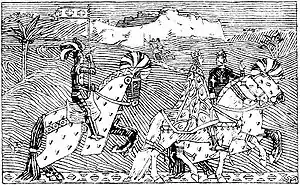Norwegian Crusade
The Norwegian Crusade, led by Norwegian King Sigurd I,[2] was a crusade or a pilgrimage (sources differ)[3] that lasted from 1107 to 1111, in the aftermath of the First Crusade. The Norwegian Crusade marks the first time a European king personally went to the Holy Land.[4]
| Norwegian Crusade | |||||||||
|---|---|---|---|---|---|---|---|---|---|
| Part of the Crusades (aftermath of First Crusade) and the Reconquista | |||||||||
 The route taken by Sigurd I to Jerusalem and Constantinople (red line) and back to Norway (green line) according to Heimskringla. (Legend in Old Norse.) | |||||||||
| |||||||||
| Belligerents | |||||||||
|
Fatimid Caliphate Almoravid Empire Taifa of Badajoz Taifa of Majorca Barbary pirates of Majorca | |||||||||
| Commanders and leaders | |||||||||
| Governor of Sidon[lower-alpha 1] | |||||||||
| Strength | |||||||||
|
Franks
Venetians
|
Fatimids
| ||||||||
The journey to Jerusalem
From Norway to England (1107-08)
Sigurd and his men sailed from Norway in the autumn of 1107 with sixty ships and perhaps around 5,000 men.[5] In the autumn he arrived in England, where Henry I was king. Sigurd and his men stayed there the entire winter, until the spring of 1108, when they again set sail westwards.
In mainland Iberia (1108–09)
After several months they came to the town of Santiago de Compostela (Jakobsland)[3] in Galicia (Galizuland) where they were allowed by a local lord to stay for the winter. However, when the winter came there was a shortage of food, which caused the lord to refuse to sell food and goods to the Norwegians. Sigurd then gathered his army, attacked the lord's castle and looted what they could there. The identity of the local lord or count is uncertain.[6]
In the spring they continued along the coast of Portugal, capturing eight Saracen galleys on their way, and then conquered a castle at Sintra (probably referring to Colares, which is closer to the sea), after which they continued to Lisbon, a "half Christian and half heathen" city, said to be on the dividing line between Christian and Muslim Iberia, where they won another battle. On their continued journey they sacked the town of Alkasse (probably Alcácer do Sal), and then, on their way into the Mediterranean, near the Strait of Gibraltar (Norfasund), met and defeated a Muslim squadron.[3]
In the Balearics (1109)
After entering the Mediterranean (Griklands hafi) they sailed along the coast of the land of the Saracens (Serkland) to the Balearic Islands. The Balearics were at the time perceived by Christians to be nothing more than a pirate haven and slaving centre. The Norwegian raids are also the first recorded Christian attacks on the Islamic Balearic Islands (though smaller attacks certainly had occurred).[3]
The first place they arrived at was Formentera, where they encountered a great number of Blåmenn (Blue or black men) and Serkir (Saracens)[3] who had taken up their dwelling in a cave. The course of the fight is the most detailed of the entire crusade through written sources, and might possibly be the most notable historic event in the small island's history.[3] After this battle, the Norwegians supposedly acquired the greatest treasures they had ever acquired. They then went on to successfully attack Ibiza and then Menorca. The Norwegians seem to have avoided attacking the largest of the Balearic Islands, Majorca, most likely because it was at the time the most prosperous and well-fortified centre of an independent taifa kingdom.[3] Tales of their success may have inspired the Catalan–Pisan conquest of the Balearics in 1113–1115.[3]
In Sicily (1109-10)
In the Spring of 1109, they arrived at Sicily (Sikileyjar), where they were welcomed by the ruling Count Roger II, who was only 12–13 years old at the time.
Kingdom of Jerusalem (1110)

In the summer of 1110, they finally arrived at the port of Acre (Akrsborg)[3] (or perhaps in Jaffa),[5] and went to Jerusalem (Jorsala), where they met the ruling crusader king Baldwin I. They were warmly welcomed, and Baldwin rode together with Sigurd to the river Jordan, and back again to Jerusalem.
The Norwegians were given many treasures and relics, including a splinter off the True Cross that Jesus had allegedly been crucified on. This was given on the condition that they would continue to promote Christianity and bring the relic to the burial site of St Olaf.
Siege of Sidon (1110)
Later, Sigurd returned to his ships at Acre, and when Baldwin was going to the Muslim town of Sidon (Sætt) in Syria (Sýrland), Sigurd and his men accompanied him in the siege. A siege that resulted in the town being taken and Lordship of Sidon being created.
The journey back to Norway
After this, Sigurd and his men sailed to Constantinople (Old Norse: Miklagard), where Sigurd left all of his ships and valuable figureheads, and many of his men, and then made his way back to Norway by land, arriving there in 1111.[3]
Notes
References
- Store norske leksikon - Sigurd 1 Magnusson Jorsalfare – utdypning (NBL-artikkel)
- Riley-Smith, 1986, p. 132
- Gary B. Doxey (1996), "Norwegian Crusaders and the Balearic Islands" Archived 2016-06-30 at the Wayback Machine, Scandinavian Studies, 10–1.
- Encyclopædia Britannica: Sigurd I Magnusson
- Krag, Klaus. "Sigurd 1 Magnusson Jorsalfare". Norsk biografisk leksikon.
- Nelly Egger de Iölster (1983), "Un paso por Galicia de un rey de Noruega en el siglo XII", Estudios en homenaje a Don Claudio Sánchez-Albornoz en sus 90 años, Vol. II, Buenos Aires: Instituto de Historia de España, pp. 267–274.
Bibliography
- Bergan, Halvor (2005) Kong Sigurds Jorsalferd. Den unge kongen som ble Norges helt (Norgesforlaget) ISBN 82-91986-75-4
- Morten, Øystein (2014) Jakten på Sigurd Jorsalfare (Spartacus) ISBN 9788243008441
- Riley-Smith, Jonathan (1986). The First Crusade and the Idea of Crusading. (University of Pennsylvania Press). p. 132. ISBN 0812213637.
External links
- "Heimskringla or The Chronicle of the Kings of Norway - Saga of Sigurd the Crusader and His Brothers Eystein and Olaf". Medieval and Classical Literature Library Release.
